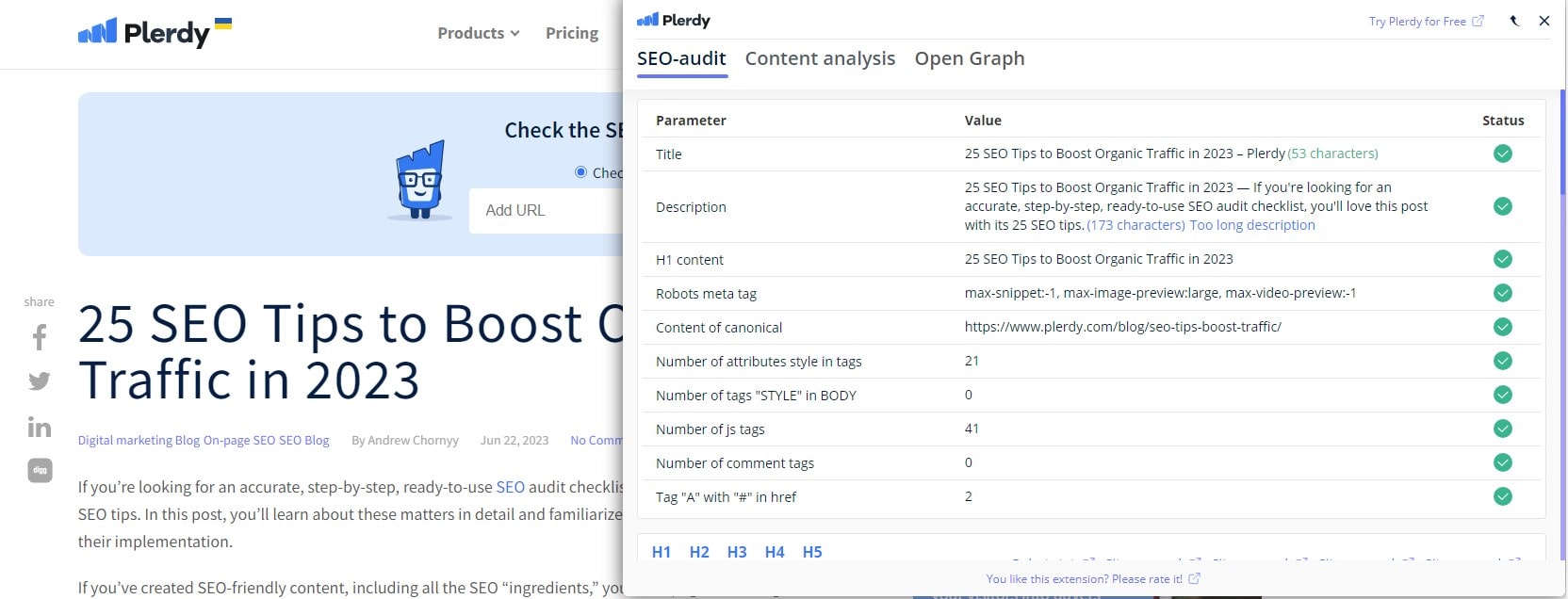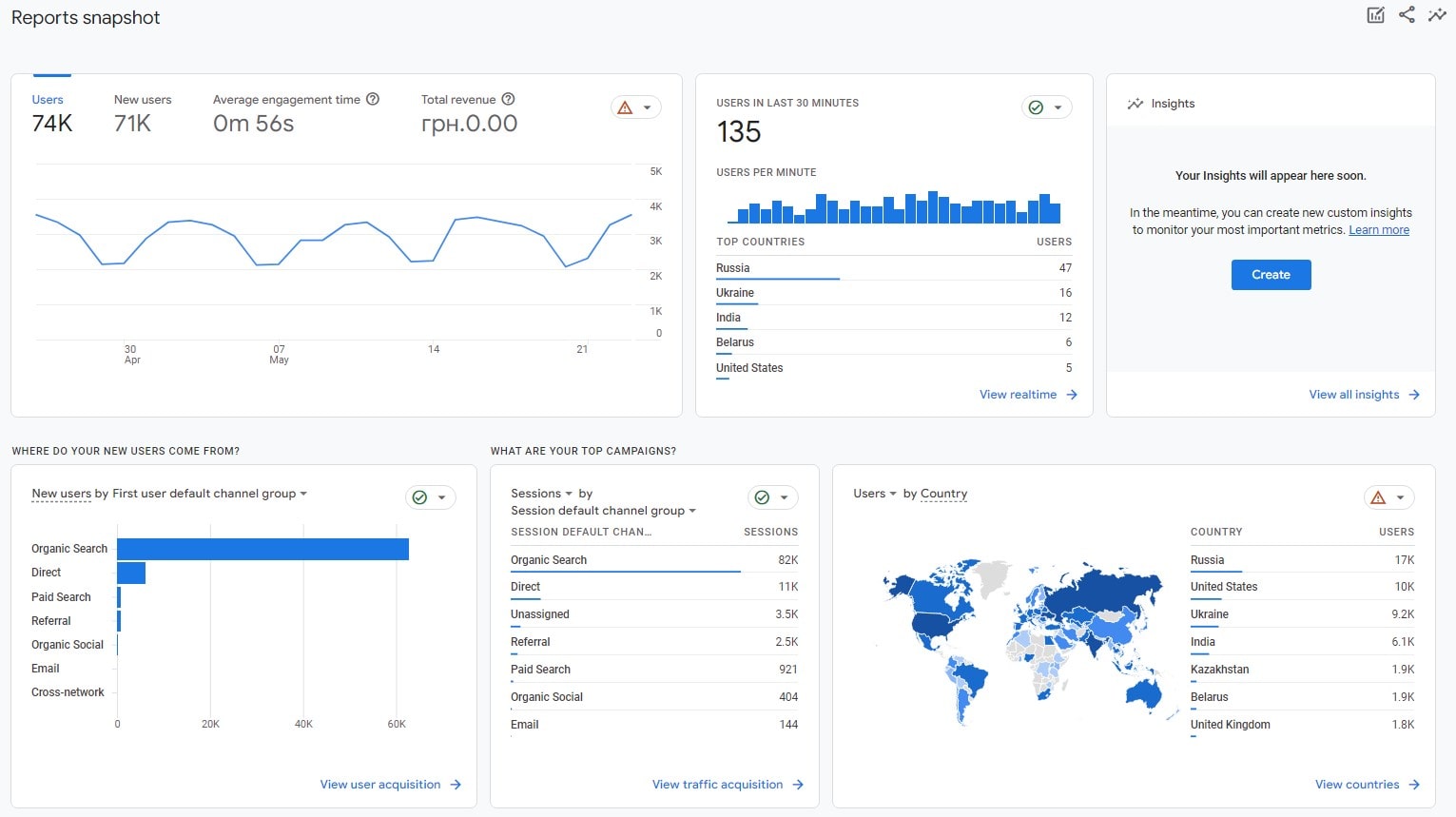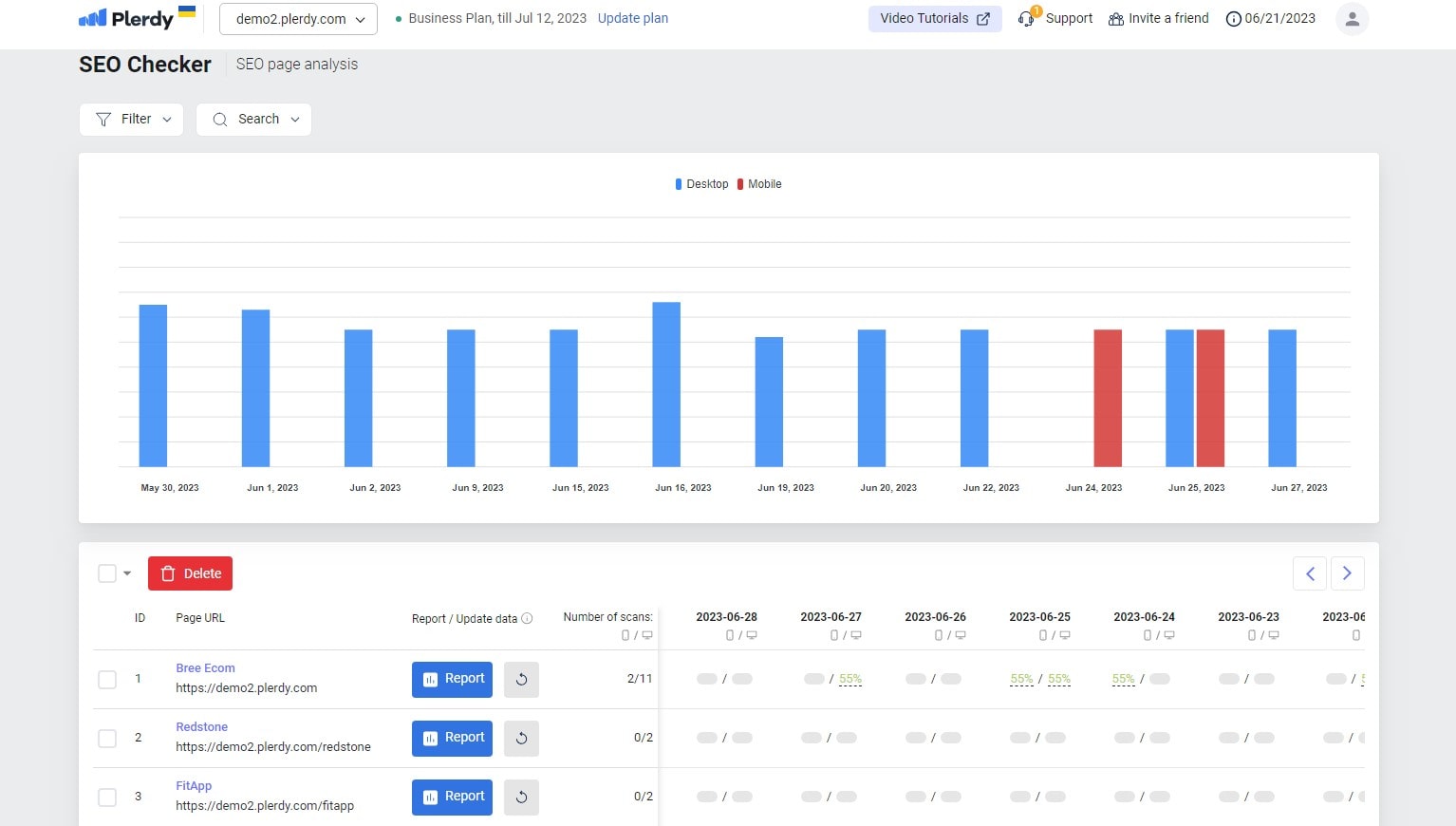Welcome to your first-hand manual for the “On-Page SEO Checker”! Combining efficiency with power, this instrument is your hidden weapon for a great-performance website. Objectives and chores? Their clarity is as perfect as a summer’s day:
- Spotting SEO Issues: Finding hidden SEO mistakes like missing keywords or tags could cause your website to fail.
- Improving Visibility: SEO Checker guarantees your material makes a difference in the huge digital terrain by improving keyword alignment.
- Boosting Organic Traffic: Improving SEO will cause a boost in natural traffic; your website will begin to attract users like a magnet!
- Monitoring Changes: Real-time tracking guarantees that your SEO is constantly in best condition by allowing you monitor of its state.
A rather good illustration of its strength? Plerdy’s search engine optimiser tool. Plerdy improves your UX and SEO research, thereby enabling you to control the performance of your website. Improve your SEO to see how quickly your website will shine. Using On-Page SEO Checker can help your website to thank you!
Plerdy SEO Checker Help Business Analyze On-Page

Using Plerdy SEO Checker, your reliable friend in the cutthroat online business scene, improve your digital profile. Designed with great care, this tool deepens and comprehensively analyzes your on-page SEO approach.
It looks like this:
- Plerdy SEO Checker painstakingly searches every inch of your website, not skipping any detail. It points up possible enhancements, thereby enabling you to maximize the visibility of your site.
- This tool transcends basic study. From a bird’s eye perspective, your site’s architecture reveals hidden potential and points out neglected SEO hazards.
- From keyword use to metadata optimization, Plerdy SEO Checker provides practical information to enable you to make decisions based on knowledge that will increase natural traffic.
Think about a busy online retailer, for example. Having poor organic search results, the store asked Plerdy to help. Following their use of the SEO Checker, they identified underused keywords, changed their metadata, and improved their on-page SEO, so increasing the natural traffic and conversion rate.
All things considered, Plerdy SEO Checker is a must-have tool for companies trying to maximize their web presence. Detailed on-page SEO analysis helps to open the road towards a strong, successful website.
What Is SEO On-Page?

The essential tool for digital success, on-page SEO loads your website with rich content and improved structures while also increasing search engine recognition. The screws and bolts keeping your online presence together are what define it.
It divides into a small number of basic elements:
- Keyword use: The correct words, at the correct places, captivate audiences and algorithms both.
- Title tags and meta descriptions: These important elements direct search engine interpretation of your page.
- URL structures: Simple, clear URLs help search engines and user experience to be better.
- Internal linking: Linking your pages increases page exposure and navigability inside your system.
Think of a bookshop putting up an internet business. Using the book title and author in the URL for every listing, a good on-page SEO plan would simplify the URL structure of their website. The product descriptions balance interesting the reader with satisfying search engine algorithms by properly using keywords. Title tags and meta descriptions would capture the core of every page and direct search engines as well as possible consumers.
Therefore, on-page SEO is about making sure search engines respect your website, so enhancing your digital presence into the forefront, not only about its appearance or UX.
Why On-Page SEO Important?

Perfect on page 1 Any website’s success is mostly dependent on SEO, a superpower that greatly increases the visibility of your website. Like the cherry on top of a cake, it adds that additional sweetness that makes all the difference.
Considering on-page SEO will help you to find internet recognition. It’s about honing the little elements—the keyword usage, meta descriptions, HTML tags that gently change the SEO profile of your website.
Here’s the reason on-page SEO is absolutely necessary:
- User Experience: Excellently done on-page SEO results in a user-friendly website with fast loading, simple navigation, and interesting text. Staying visitors are more likely to help to lower bounce rates.
- Organic Visibility: On-page SEO improves the relevance of your website for search queries, so increasing its profile in search results.
- Local SEO: Improves local search, so essentially mapping your company for local searches.
- Credibility: Excellent material, careful keyword use, and strong links give your website legitimacy and help to build user confidence.
Think about the really well-known SEO Checker application Plerdy. It maximizes on-page SEO by spotting any problems and guiding you in fast fixes. Simplifying on-page SEO lays a firm basis for your website, thereby increasing its visibility, relevance, and usability. Although great SEO is not a quick fix, with the correct checker tool you will most definitely be within reach!
Get A Report On All Pages Of Your Site With Plerdy

Plerdy is a lighthouse of clarity in the continuously changing field of digital marketing since it provides thorough analyses on every page of your website. This on-page SEO analyzer helps companies to improve their internet presence, therefore opening the road of success.
Plerdy operates in this manner:
- It reads every inch of your website in great detail.
- It provides a detailed analysis highlighting your on-page search engine optimization.
- It provides practical advice to improve the functionality of your website.
Imagine a growing blog ready to attract more readers. Working with Plerdy, they were able to clearly see their on-page search engine optimization. Their approach was changed using the knowledge from the thorough report, which resulted in more natural traffic and interaction.
All things considered, Plerdy offers a thorough, birds-eye perspective of the on-page SEO on your website together with data-driven ideas to improve your online presence and performance. Exposing the details of your site helps you to make wise selections and get best outcomes.
How To Do On-Page SEO Audits?
Using Plerdy SEO Checker can help you to maximize natural traffic, find important SEO problems, and improve your website. Use it like this:
- SEO Page Analysis: Launch Plerdy SEO Checker then choose the audit date you want. Remember: SEO data changes quickly; a changed meta description or title will have instant effects.
- Applying Filters: Using filters or the search bar can help you customize your reports. This enables one to search for particular problems or check particular web sites.
- SEO Health Score: Check the SEO health score of your website; divide it into two parts: desktop and mobile. Given that device type affects optimization, this is absolutely vital.
Take a blog post full of SEO issues, for example: missing descriptions, absent H1 tags, banned robots, and spelling flaws. Plerdy SEO Checker exposes these problems and lets one compare several dates to find when a problem started.
Moreover, Plerdy offers a “Content Analysis” report that evaluates your material depending on several criteria including character count, unique word count, stop word percentage, and water score (stop word %).
For more understanding of the SEO performance of your website, you can also explore “Relevance” and “Duplicates” reports. Once finished, see the general SEO health score for each page or export the data to Google Spreadsheets for an all-encompassing study.
Your one-stop for flawless on-page SEO audits is Plerdy SEO Checker.
How To Find Missing Keywords With GSC And Optimize On-Page?
How Can One Search Missing Keywords Using GSC and Optimize On-Page?
Find missing keywords using Google Search Console (GSC) and Plerdy SEO Checker to improve on-page SEO of your website. Discover these hidden treasures and see right away impressions, clicks, and conversion increase. Your road map consists of:
- Integration of GSC: With Plerdy SEO Checker can help you sail. Use the four easy steps after navigating through SEO Checker > SEO settings > Google Search Console API.
- Navigate to GSC Tab: Once finished, go to the GSC tab to obtain key data – clicks, impressions, locations, and CTR.
- Reveal the Missing Keywords: Pay now more attention to the “Page” tab. This shows your web pages, arranged in performance order. The first report, “Present in GSC and absent on the page,” notes missing keywords by matching the search queries on your website with its content.
- Track non-performing words: The last two reports, “Present on the page and absent in GSC,” enable you to spot phrases not improving the search engine optimization of your page. These could indicate that these search terms demand greater traffic or interest.
For instance, your page mostly addresses homepage and website design. You are losing out on the keyword “cool,” which has a noteworthy impression count from the GSC report. Slides this keyword into a phrase or paragraph, and see how relevant your page becomes, more impressions show, and higher positions result.
Using Plerdy SEO Checker and Google Search Console—an unequaled mix for great website optimization—take your on-page SEO to new boundaries.
Finish
Deciphering the digital maze of on-page SEO is like learning a complex dance, a careful mix of science and art. Perfected results are transforming – improved exposure, more credibility, and a powerful user experience.
Using the features of an on-page SEO checker is like having a reliable sidekick—a constant collaborator that painstakingly finds and fixes onsite problems. These tools guarantee your website runs like a well-oiled machine from broken links to underperforming keywords.
Moreover, contemporary solutions like Plerdy transcend basic SEO audits. They explore the challenging UX & SEO analysis field and offer ideas that significantly affect the performance of the website. This checker has features including:
- Problem-solving: Notes mistakes and provides perceptive advice on how to fix them.
- SEO checkup: Does a thorough site-wide SEO check including off-page elements?
- Analytics: Monitors user sessions in order to maximize user behavior by means of statistical data.
Finally, an on-page SEO checker directs you toward answers, helps control SEO complexity, and turns your website into an SEO-friendly hub from analysis alone. Not only let your website exist; help it to flourish. Try Plerdy right now to start clearing the path for your online success!
